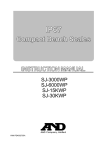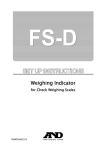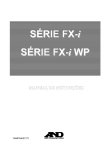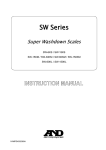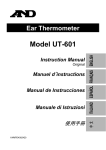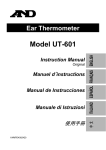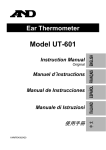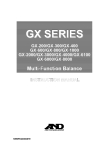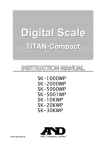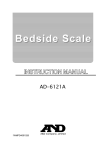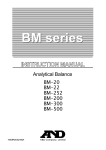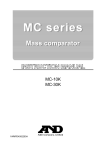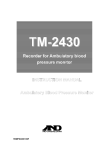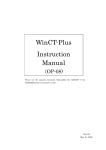Download A&D AD-4212B-23 Instruction manual
Transcript
Pipette Accuracy Tester PT-Series AD-4212B-PT AD-4212A-PT FX-300i-PT INSTRUCTION MANUAL 1WMPD4001794D © 2015 A&D Company, Limited. All rights reserved. No part of this publication may be reproduced, transmitted, transcribed, or translated into any language in any form by any means without the written permission of A&D Company, Limited. The contents of this manual and the specifications of the instrument covered by this manual are subject to change for improvement without notice. Microsoft, Windows, Excel and Word are either registered trademarks or trademarks of Microsoft Corporation in the United States and/or other countries. CONTENTS 1. INTRODUCTION .............................................................................................................................2 1-1 Unpacking the Tester.......................................................................................................................... 2 1-2 Description of Each Component......................................................................................................... 3 1-3 WinCT-Pipette, Software for Pipette Accuracy Testing....................................................................... 4 1-4 Function of the Evaporation Trap ....................................................................................................... 5 1-5 Description of a Sample Cup.............................................................................................................. 5 2. ASSEMBLING THE TESTER..........................................................................................................6 2-1 AD-4212B-PT / AD-4212A-PT ............................................................................................................ 6 2-2 FX-300i-PT ......................................................................................................................................... 8 3. PRECAUTIONS BEFORE USE ....................................................................................................10 4. ANTI-STATIC TREATMENT ..........................................................................................................11 5. INSTALLING WinCT-Pipette ........................................................................................................11 6. CONNECTING A PC TO THE BALANCE.....................................................................................12 6-1 Connecting a PC .............................................................................................................................. 12 6-2 Checking COM Port Numbers.......................................................................................................... 13 7. CALIBRATING THE BALANCE ...................................................................................................14 7-1 AD-4212B-PT / AD-4212A-PT .......................................................................................................... 14 7-2 FX-300i-PT ....................................................................................................................................... 15 8. PREPARATION BEFORE USE.....................................................................................................16 8-1 Filling the Evaporation Trap with Water............................................................................................ 16 8-2 Preparing the Test Liquid.................................................................................................................. 16 8-3 Preparing the Water-absorbent Sheet.............................................................................................. 16 8-4 Using the Thermometer.................................................................................................................... 17 9. MEASUREMENT ..........................................................................................................................23 9-1 Measuring Procedure ....................................................................................................................... 23 9-2 Judging the Results .......................................................................................................................... 23 9-3 Example Causes of Measurement Errors ........................................................................................ 23 10. AD-4212B-PT / AD-4212A-PT ....................................................................................................25 10-1 Factory Settings.............................................................................................................................. 25 10-2 Display Lock Function .................................................................................................................... 26 10-3 Auto Print Mode .............................................................................................................................. 26 11. TROUBLESHOOTING ................................................................................................................27 12. SPECIFICATIONS.......................................................................................................................28 12-1 Options ........................................................................................................................................... 29 13. APPENDIX ..................................................................................................................................30 1 1. INTRODUCTION The PT series Pipette Accuracy Tester performs an accuracy test of the volume of a pipette in accordance with ISO 8655. This manual describes how the PT series Pipette Accuracy Tester works and how to get the most out of it in terms of performance. It includes how to assemble the tester, how to measure and how to use the software, WinCT-Pipette, for pipette accuracy testing. Read this manual thoroughly before using the tester and keep it at hand for future reference. For detailed information on handling the balance, refer to the instruction manual for the balance used. NOTE ISO 8655 is the international standard that includes pipette calibration and specifies a test method for accuracy of the pipette volume. For detailed information, visit our web site. 1-1 Unpacking the Tester NOTE The pipette accuracy tester is contained in a carrying case. The case is only for carrying the tester and is not solid enough to endure transportation. So, do not transport the tester using the carrying case. When transporting the tester, be sure to use the original packing material. When handling the tester, be careful not to drop it, even if it is placed in the carrying case. The illustrations below show what the PT series consists of. Note that the USB converter is shipped in a separate package, but it can be placed in the carrying case as shown below. A shoulder belt and a key are provided with the carrying case. Use the shoulder belt to carry the case. NOTE Please confirm that the AC adapter type is correct for your local voltage and power receptacle type. AD-4212B-PT / AD-4212A-PT The connection cable provided as an accessory is one meter long. 2 FX-300i-PT 1-2 Description of Each Component Evaporation trap A chamber to prevent the evaporation of the dispensed test liquid (distilled water). (Refer to “1-4 Function of the Evaporation Trap”.) Sample cup (Two types: 5 mL and 30 mL) A measuring cup to contain the test liquid dispensed from a pipette, with a water-absorbent sheet installed, to prevent water droplets from remaining on the edge of the pipette tip. Test liquid cup A container to keep a test liquid such as distilled water. Thermometer (with a clamp) Measures the temperature of the test liquid. RS-232C cable and USB converter Connects to a PC (personal computer) to transmit the test values to the PC. WinCT-Pipette Software for pipette accuracy testing to convert the test liquid mass into a volumetric value. Calibration weight (with a pair of tweezers to handle the weight) A weight to calibrate the balance. 3 1-3 WinCT-Pipette, Software for Pipette Accuracy Testing Features The mass value of the distilled water dispensed from a pipette is transmitted from the balance to a PC. Using the temperature of the test liquid and the barometric pressure that are previously entered, the PC calculates the conversion factor (Z factor) from a mass value to a volumetric value and converts the mass value into a volumetric value automatically, using the Z factor. The measurement results are compared with the specifications previously entered, to perform judgment whether the pipette will pass or fail. Besides the pipette volume, test numbers, test dates and pipette information (manufacturer, model, serial number) can be recorded as test data. The test data, output to a printer or stored in the PC, allows easy management of pipette accuracy and reduces errors due to data mismanagement. The specifications of accuracy and repeatability can be entered either as an absolute value (L) or as a relative value (percentage to the pipette volume). The mass value data from the balance can be transmitted to the PC either using a COM port or using a USB connection. (For a USB connection, use the accessory USB converter.) For testing various pipettes easily, multiple test conditions (pipette volume, number of measurements and specifications) can be set previously. When multiple operators are set previously, an operator can be selected easily as necessary. NOTE For detailed information on WinCT-Pipette, refer to “How to use WinCT-Pipette.pdf” in the WinCT-Pipette CD-ROM. Main Window When WinCT-Pipette starts up, the window below opens Specifications Enter the pipette volume, specifications of accuracy and repeatability used for pass/fail judgment. Measured Values Displays the mass values transmitted from the balance and the volumetric values obtained using the Z factor. Measurement Results Displays the measurement results and Measurement environment Enter the ambient relative humidity, the distilled water temperature and the barometric pressure. The Z factor is automatically calculated using the values of the distilled water temperature and the barometric pressure. judgment results. 4 1-4 Function of the Evaporation Trap In the pipette accuracy test using the gravimetric method, to obtain the mass of the test liquid, distilled water is dispensed from the pipette into the sample cup installed on the balance. The obtained value, however, is generally smaller due to evaporation loss of the test liquid. To prevent evaporation of the test liquid, the evaporation trap is used. The ISO 8655 standard recommends that the humidity of the measurement environment be greater than 50% RH. Water is poured into the groove of the evaporation trap. This helps to maintain the humidity inside the evaporation trap high and reduces evaporation. Using the evaporation trap reduces the evaporation of the test liquid, compared with when the evaporation trap is not used. This yields a measurement environment where there is no need to consider measurement errors due to evaporation loss of the test liquid. Another function of the evaporation trap is one as a breeze break, to prevent drafts in the measurement environment from influencing the weighing operation and enable a stable weighing. The evaporation trap is designed for an easy dispensing of the test liquid. The upper part has a sloped surface so that the pipette can be inserted from obliquely above. 1-5 Description of a Sample Cup When dispensing a test liquid from the pipette, to perform an accuracy test of the volume of a pipette, a possible cause of errors is water droplets remaining on the edge of the pipette tip. Using the water-absorbent sheet in the sample cup prevents this and increases the accuracy of a test. As shown in the illustration below, a water-absorbent sheet is rolled into a cylinder and is placed along the inner wall of the sample cup. By dispensing the test liquid with the edge of the pipette tip touching the sheet, the sheet will absorb any droplet which may otherwise remain on the edge of the tip. Thus all the test liquid will be dispensed into the sample cup. The water-absorbent sheets are made of a RoHS-compliant material for safety. The sheet, once used, can be cleaned and used repetitively. 5 2. ASSEMBLING THE TESTER 2-1 AD-4212B-PT / AD-4212A-PT 1. Place the weighing unit on a solid table. For details on the installation site, refer to “3. PRECAUTIONS Display BEFORE USE”. Connection cable Secure the display to the stand using the angle adjustment knobs. Connect the display and the weighing unit using the connection cable. Weighing unit Stand Angle adjustment knob 2. Install the evaporation trap base on the weighing Evaporation trap base unit. 3. Install the sample cup holder (30 mL) on the base. 5 mL sample cup When the 30 mL sample cup is used: Insert the sample cup into the holder. NOTE Sample cup holder (5 mL) The actual capacity of the 30 mL sample cup is 25 mL. Sample cup holder (30 mL) When the 5 mL sample cup is used: Insert the sample cup holder (5 mL) into the sample cup holder (30 mL), and then insert the sample cup 6 30 mL sample cup 4. Install the lower part of the evaporation trap on the weighing unit, mating the tabs with the holes on the Lower part of the evaporation trap base. Tab Hole 5. Attach the upper part of the evaporation trap to the Upper part of the evaporation trap lower part, mating the tab with the notch. Tab Lower part of the evaporation trap Notch 6. Adjust the direction of the evaporation trap so that the pipette insertion opening on the sloped surface is faced to allow easy operation. Pipette insertion opening Facing to the left of the weighing unit Facing to the right of the weighing unit 右 左 Pipette insertion opening Cap B 7. Install cap B on the evaporation trap. Remove cap A from the sloped surface. Upper part of the evaporation trap 7 Cap A 2-2 FX-300i-PT 1. Place the balance on a solid table. For details on the installation site, refer to “3. PRECAUTIONS BEFORE USE”. . 2. Install the fitting boss on the balance, then install Evaporation trap base the evaporation trap base on the fitting boss. Fitting boss 3. Install the sample cup holder (30 mL) on the base. 5 mL sample cup When the 30 mL sample cup is used: Insert the sample cup into the holder. NOTE The actual capacity of the 30 mL Sample cup holder (5 mL) sample cup is 25 mL. When the 5 mL sample cup is used: Sample cup holder (30 mL) Insert the sample cup holder (5 mL) into the sample cup holder (30 mL), and then insert the sample cup 8 30 mL sample cup 4. Install the lower part of the evaporation trap on the weighing unit, mating the tabs with the holes on the Lower part of the evaporation trap base. Tab Hole 5. Attach the upper part of the evaporation trap to the Upper part of the evaporation trap lower part, mating the tab with the notch. Tab Lower part of the evaporation trap Notch 6. Adjust the direction of the evaporation trap so that the pipette insertion opening on the sloped surface is faced to allow an easy operation. Pipette insertion opening Facing to the right of the balance 右 Facing to the left of the balance 左 Pipette insertion opening Cap B 7. Install cap B on the evaporation trap. Remove cap A from the sloped surface. Upper part of the evaporation trap 9 Cap A 3. PRECAUTIONS BEFORE USE To get the optimum performance from the balance and acquire accurate weighing data, note the following, especially when using the AD-4212B-PT / AD-4212A-PT with a minimum weighing value of 0.001 mg / 0.1 mg. Install the balance where the measurement environment is appropriate. The best operating temperature is 15°C to 30°C ±0.5°C with greater than 50% RH. Install the balance where it is not exposed to direct sunlight and it is not affected by air from heaters or air conditioners. Especially be careful when using the AD-4212B-PT. It responds even to very subtle airflow. Install the balance where it is free of dust. Install the balance away from equipment which produces magnetic fields. Install the balance in a stable place avoiding vibration and shock. Corners of rooms (close to pillars or walls) far from a passage way are best, as they are less prone to vibration. The weighing table should be solid and free from vibration, drafts and as level as possible. Level the balance by adjusting the leveling feet and confirm it using the bubble spirit level. Before use, warm up the balance for the appropriate duration, with nothing on the weighing pan. AD-4212B-PT / AD-4212A-PT: one hour or more FX-300i-PT: 30 minutes or more When using the AD-4212B-PT with a minimum weighing value of 0.001 mg, keep the balance connected to power constantly. Calibrate the balance before use or after having moved it to another location. Use the accessory calibration weight for calibration. For details, refer to “7. CALIBRATING THE BALANCE”. Caution Do not install the balance where flammable or corrosive gas is present. 10 4. ANTI-STATIC TREATMENT An anti-static treatment has been applied to the evaporation trap. Cleaning it with alcohol will reduce the effect of the treatment. If the evaporation trap has acquired a static charge, apply an anti-static agent or use the optional AD-1683 DC static eliminator to remove the static electricity. 5. INSTALLING WinCT-Pipette For detailed information on the WinCT-Pipette program, refer to “How to use WinCT-Pipette.pdf ” in the WinCT-Pipette CD-ROM. For installing WinCT-Pipette, refer to “Readme.txt” in the WinCT-Pipette CD-ROM. System requirements OS CPU RAM Hard disk available space Display Windows XP SP2 or later Pentium or the equivalent, 1GHz or more recommended 512 MB or more recommended Approximately 50 MB 1024 x 768 or more recommended 11 6. CONNECTING A PC TO THE BALANCE To make a connection between a PC and the balance, use the RS-232C cable or use both the RS-232C cable and the USB converter. 6-1 Connecting a PC When a PC COM port is used When using the COM port of a PC to make a connection to the balance, use the accessory RS-232C cable. AD-4212B-PT / AD-4212A-PT FX-300i-PT When a PC USB port is used When using the USB port of a PC to make a connection to the balance, use both the accessory RS-232C cable and the USB converter (shipped in a separate package). The USB converter, when connected to the USB port of a PC, adds a COM port to the PC. When connecting the USB converter to the USB port for the first time, installing a driver is required. (Some PCs may require a driver installation even when the USB port used is changed.) The driver installation CD and the instruction manual are contained in the same package with the USB converter. For instructions on installation, read the manual. After driver installation, connect the USB converter to the balance, using the RS-232C cable. Now a COM port is added and communications between the PC and the balance is enabled. NOTE Although the USB converter is shipped in a separate package, it can be placed in the carrying case. RS-232C interface USB converter AC adapter jack RS-232C cable AC adapter jack RS-232C interface USB converter RS-232C cable Weighing unit connection jack Personal computer Personal computer AD-4212B-PT / AD-4212A-PT FX-300i-PT 12 6-2 Checking COM Port Numbers COM port numbers vary depending on the PC used. Use the Windows Device Manager to check COM port numbers. NOTE When the USB converter is used, check the COM port number with the USB converter connected. 1 Click [Start], [Settings] and [Control Panel]. 2 Double-click [System]. 3 Click [Hardware] and [Device Manager]. 4 Double-click [Port (COM & LPT)]. COM port numbers will be displayed. When the USB converter is used, “ATEN USB to Serial Bridge (COMx)” appears. In the example below, the COM port number is 4. The COM port for a personal computer is displayed as “Communications Port (COMx)”. In the example below, the personal computer has two COM ports. Therefore, two COM ports appear; “Communications Port (COM1)” and “Communications Port (COM2)” Change the WinCT-Pipette COM port number to that of the COM port used. Checking COM port numbers in [Device Manager] 13 7. CALIBRATING THE BALANCE For details on calibration, read the balance instruction manual in addition to this manual. Before calibration, refer to “3. PRECAUTIONS BEFORE USE”. Especially when calibrating the AD-4212B-PT / AD-4212A-PT with a minimum weighing value of 0.001 mg / 0.1 mg, make sure that the installation environment is appropriate and the balance is warmed up for the appropriate duration. 7-1 AD-4212B-PT / AD-4212A-PT 1. Remove the sample cup, but leave two sample cup holders (5 mL and 30 mL) inside Sample cup holder (5 mL) the evaporation trap, as shown to the right. Upper part of the evaporation trap Lower part of the evaporation trap 2. Press and hold the CAL key until Calout is displayed, then release the CAL key. 3. When Cal 0 is displayed, press the Sample cup holder (30 mL) PRINT key to enter the zero point. Tab 4. After the zero point is entered, the calibration weight value 50 is displayed. Remove the upper part of the evaporation trap while holding the lower part of the Calibration weight (50 g) evaporation trap. Place the accessory calibration weight on the sample cup holder (5 mL). Attach the upper part of the evaporation trap to the lower part, mating the tab with the notch. 5. Press the PRINT key to calibrate the weighing capacity. When end is displayed, remove the calibration weight. The balance will return to the weighing mode. 6. Place the calibration weight on the sample cup holder (5 mL) to confirm that calibration has been completed successfully. 14 Notch 7-2 FX-300i-PT 1. Remove the 30 mL sample cup and leave Upper part of the evaporation trap only the sample cup holder (30 mL) inside the evaporation trap as shown to the right. Lower part of the evaporation trap 2. Press and hold the CAL key until Calout is displayed, then release the CAL key. 3. When Cal 0 Sample cup holder (30 mL) is displayed, press the PRINT key to enter the zero point. Tab (4 in all) 4. After the zero point is entered, the calibration weight value 100 is displayed. Calibration weight (100 g) Remove the evaporation trap by holding the lower part of the evaporation trap. Place the accessory calibration weight on the sample cup holder (30 mL). Base Attach the evaporation trap on the base, Hole (4 in all) mating the tabs with the holes. 5. Press the PRINT key to calibrate the weighing capacity. When end is displayed, remove the calibration weight. The balance will return to the weighing mode. 6. Place the calibration weight on the sample cup holder (30 mL) to confirm that calibration has been completed successfully. NOTE The evaporation trap can be used as a breeze break. Calibration can be performed, using the weighing pan and the breeze break provided as accessories. 15 8. PREPARATION BEFORE USE The measurement environment recommended by ISO 8655 is as follows. Temperature: Constant between 15°C and 30°C, changes in temperature ±0.5°C. Humidity: Greater than 50% RH 8-1 Filling the Evaporation Trap with Water Remove the evaporation trap from the balance. Separate the upper and lower part of the evaporation trap. Pour water into the groove along the circumference of the inner wall of the lower part of the evaporation trap, using a wash bottle or a pipette, up to the center between the two lines on the evaporation trap. Wash bottle NOTE When pouring water, use much care not to spill water around the fitting boss of the balance weighing pan. Lower part of the evaporation trap Water level reference lines Attach the upper part of the evaporation trap to the lower part and place the evaporation trap on the balance or weighing unit. It takes approximately 15 minutes for the humidity inside the evaporation trap to stabilize to about 85% RH. The time required for the humidity to stabilize varies depending on the measurement environment. 8-2 Preparing the Test Liquid Pour distilled water into the test liquid cup. Place the thermometer in the cup, using the clamp as shown below. Leave as is to allow the temperature of the distilled water to stabilize. ISO 8655 recommends that the test liquid be acclimatized to the measurement environment for two hours or more. Thermometer Clamp Insert the thermometer into the cup so that the clamp is hooked on the edge of the cup. Test liquid cup 8-3 Preparing the Water-absorbent Sheet To stabilize the evaporation amount of the dispensed test liquid from the sheet, moisten the sheet with the test liquid (approx. 600L for the 5-mL sample cup sheet, and approx. 4000L for the 30-mL sample cup sheet) before the test. 16 8-4 Using the Thermometer Each part name LCD Battery cover [ON/OFF] button [AUTO OFF] button [MAX/MINI] button Sheath holder Sheath Material: Main body, battery cover: Acrylonitrile-butadiene- styrene (ABS) Button: Rubber Display: Polycarbonate (PC) Sheath: SUS304 Sheath holder: Polycarbonate (PC) Sheath holder fitting: Iron (Nickel plating) Display Auto power off function Maximum value display Minimum value display Measurement temperature display (Maximum value /Minimum value display) Low battery indicator Error display lo Hi Appears when the measurement temperature is below the lower limit for the display range, or there is an error in the temperature sensor or internal circuit. Appears when the measurement temperature exceeds the upper limit for the display range, or there is an error in the temperature sensor or internal circuit. 17 Replacing The Battery The battery is not installed when you purchase the thermometer. Properly install the battery in the thermometer by the following procedure. Also, when the “ ” indicator appears at the bottom right in the display, replace the old battery with a new one by the following procedure. * Purchase the battery at your local convenience store, supermarket, hardware store or electrical store. * When the main body is damp, wipe the moisture fully and replace the battery. The thermometer may be damaged if water gets inside. 1. Turn the battery cover on the rear side of the main body in counterclockwise direction by using a coin, and remove the battery cover. 2. Remove the old battery. 3. Place a new CR2032 coin type lithium battery with the + side facing up. 4. Place the battery cover back on. As shown in the figure below, place the battery cover so that the mark on the battery cover is aligned with the upper mark on the main body. Then, turn the battery cover in clockwise direction using a coin until the mark on the battery cover is aligned with the lower mark on the main body. The battery cover that is not secured properly may result in entering water inside and damaging the thermometer. O PE N CL O SE CLOSE OPEN CAUTION Precautions on the battery use The provided battery is for monitoring purposes, and its life may therefore be shorter than the battery life specified in this manual. Remove the battery from the thermometer and keep it elsewhere when you are not using the thermometer for a long period of time. Use the specified battery (CR2032 coin type lithium battery 1 pc) only. Be sure to insert the battery with the + side facing up. Reverse polarity may not only cause operation errors but also damage the thermometer. Do not recharge the battery, short-circuit, disassemble or thrown into the fire. It may explode or leak and cause personal injury. Keep the battery out of the reach of children. If swallowed, consult a physician immediately. For environmental protection, follow the local regulations to dispose of a used battery. 18 Measuring the temperature 1. Press the [ON/OFF] button to turn the power on. 2. Remove the sheath holder when it is attached to the sheath. 3. Measure the temperature by one of the following methods depending on the material to be measured. When measuring the liquid Immerse the sensor into the position where you would like to measure the temperature. When there is steam arising from the liquid, handle the thermometer so that the display is not exposed to the steam. Otherwise the steam may damage the thermometer. When measuring the semisolid material Stick the sensor to the depth where you would like to measure the temperature in the material. Attempting to forcibly stick the sensor into the material when the measurement material is too solid may damage the sheath. In such case, a device that enables smooth insertion of the sensor is required. 19 When measuring the gas Place the sensor in the location where you would like to measure the temperature and wait until the display becomes stable. When measuring a high temperature atmosphere such as steam, use a shield to protect the display from high temperature. Gas Shield CAUTION The thermometer detects a temperature at the tip of the sheath. To protect the thermometer from damage, do not expose parts other than the sheath to high or low temperatures of the substances to be measured. Sheath Temperature detection part Storing the maximum and minimum temperatures in memory The thermometer can automatically store the maximum Currently measured temperature and minimum temperatures measured after the battery is installed in the thermometer (or after the memory is Press the reset). [MAX/MIN] button Press the [MAX/MIN] button to display the maximum or Maximum temperature display minimum temperature as shown on the right. Press the [MAX/MIN] button Minimum temperature display Press the [MAX/MIN] button 20 The thermometer automatically displays the current measurement temperature if no operation is made for 30 seconds while on the maximum or minimum temperature display To check the maximum and minimum temperatures for a new measurement, reset the memory before starting the measurement as described in “Resetting the maximum and minimum temperatures stored in memory” below. CAUTION The maximum and minimum temperatures stored in memory are reset automatically when the battery is removed from the thermometer. Resetting the maximum and minimum temperatures stored in memory To reset the maximum and minimum temperatures stored in memory, perform the following: Press the [MAX/MIN] button to display the maximum or minimum temperature. Press the [MAX/MIN] button again and hold it for more than two seconds. The display goes into the bar display, and both the maximum and minimum temperatures stored in memory are reset to store new maximum and minimum ℃ MAX temperatures. . About the auto power off function and turning the power off Auto power off function The thermometer has the auto power off function. The auto power off function is disabled when the battery has been replaced. To enable the auto power off function, press the [AUTO OFF] button one time. The “AUTO” appears at the upper right in the display to show that the auto power off function is now enabled. With the auto power off function, the thermometer automatically turns the power off when no operation is made for about five minutes. To disable the auto power off function, press the [AUTO OFF] button again. The “AUTO” at the upper right in the display disappears, and the auto power off function becomes disabled. Turning the power off To turn the power off immediately, press the [ON/OFF] button. 21 ℃ AUTO How to use the sheath holder Use the sheath holder to protect the sheath when you carry the thermometer. Be sure the sheath holder is removed from the sheath when performing measurements. To prevent the sheath holder from deformation or damage, before using the sheath holder, allow the sheath to return to room temperature after high or low temperature measurements. Daily care Accurate measurements cannot be made if the temperature detection part is dirty. It should be kept clean when performing measurements. Do not rub the main body to clean. Rinse the dirt off using water. When the dirt is hard to remove, wipe it off gently using a kitchen sponge, etc., dampened with a neutral detergent. Do not use abrasives or volatile solvents such as thinner or benzine. Specifications Sensor : Thermistor Temperature measurement range : -40.0°C to +260.0°C Display resolution : 0.1°C Measurement accuracy : ±1.0°C (-9.9 to 59.9°C) ±2.0°C (-19.9 to -10.0°C, 60.0 to 99.9°C) ±3.0°C (-29.9 to -20.0°C, 100.0 to 199.9°C) ±4.0°C (-40.0 to -30.0°C, 200.0 to 260.0°C) Display refresh rate : Every second Waterproof level : JIS IPX7 (Waterproof for 30 minutes at a water depth of 1 meter, still water at room temperature) Power supply : CR2032 x 1 pc Battery life : Approx.1 year (When used for one hour per day) Operating temperature and humidity : 0 to 40°C, 75%RH or less, No condensation (Excluding the sheath) Storage temperature and humidity : 0 to 50°C, 75%RH or less, No condensation External dimensions of the sheath : 2.8 mm (Tip: 2.2 mm, length 20 mm) Approx. 120 mm long External dimensions : 40(W) x 187(H) x 17(D) mm (Excluding the protrusion) Weight : Approx. 27 g (Including the battery and sheath holder) Standard accessories : Instruction manual, sheath holder, battery (For monitoring purposes) 22 9. MEASUREMENT 9-1 Measuring Procedure Using the predetermined pipette volume, perform the measurement the specified times. ISO 8655 recommends ten measurements for each for the volumes described below. At the nominal volume of a fixed volume pipette At the following three points of an adjustable volume pipette 1. 10% of the maximum volume or the lower limit of the adjustable volume range, whichever is greater. 2. 50% of the maximum volume 3. 100% of the maximum volume NOTE Pipette volumes and number of measurements can be changed. 9-2 Judging the Results WinCT-Pipette converts the mass values into volumetric values, compares these with the predetermined judgment standard and performs judgment whether the pipette will pass or fail. Judgment standard The averaged value (exceeds / does not exceed) the specified maximum permissible error. Repeatability (exceeds / does not exceed) the specified maximum permissible error. 9-3 Example Causes of Measurement Errors Evaporation of the test liquid Evaporation of the distilled water dispensed from the pipette into the sample cup can be a cause of measurement error. To reduce errors caused by evaporation Be sure to use the evaporation trap. Using the evaporation trap, evaporation of the test liquid can be reduced to 0.05 mg per minute (0.05 L per minute). With the AD-4212B-PT / AD-4212A-PT, use the display lock function. For details, refer to “10-2 Display Lock Function”. Water temperature and barometric pressure Correctness of the Z factor, that is used to convert a mass value to a volumetric value, depends on the density by the water temperature. The barometric pressure, even if changed in the range between 950 hPa and 1050 hPa, influences measurements only by 0.01%. Water temperature, if changed by 5°C, influences measurements by 0.11%. 23 To reduce errors caused by water temperature Use the correct Z factor. To obtain the correct Z factor, measure the water temperature using the accessory thermometer and enter the value in WinCT-Pipette. For a stable water temperature, allow the temperature of the test liquid to acclimatize to the measurement environment for an appropriate duration of time (ISO 8655 recommends two hours or more) before measurement. Vibration Vibration yields unstable measurement values. To reduce errors caused by vibration Install the balance in a stable place avoiding vibration and shock. Use a solid weighing table that is free from vibration. If the installation site is the second floor or higher, use the AD-1685 anti-vibration table. Airflow Airflow in the measurement environment yields unstable measurement values To reduce errors caused by airflow Install the balance where it is not affected by heaters or air conditioners or where no drafts exist. Especially when using the AD-4212B-PT / AD-4212A-PT with a minimum weighing value of 0.001 mg / 0.1 mg, use much care in choosing an installation site or cover the weighing unit. Operator An operator’s pipetting technique influences measurements. To reduce errors caused by the pipetting technique Learn and use the correct pipette technique. 24 10. AD-4212B-PT / AD-4212A-PT The AD-4212B-PT / AD-4212A-PT is designed exclusively as a pipette accuracy tester. Although the performance as a balance is the same as the AD-4212B / AD-4212A production weighing unit, some of the specifications are different. 10-1 Factory Settings When shipped, the factory settings of the AD-4212B-PT / AD-4212A-PT as a pipette accuracy tester are as follows. Unit Weighing unit: mg Minimum weighing value for the AD-4212B-PT: 0.1 mg Each time the SAMPLE key is pressed, the minimum weighing value changes as below: 0.1 mg 0.01 mg 0.001 mg 1 mg 0.1 mg Press the SAMPLE key to switch the minimum weighing value as necessary. For testing a liquid with a volume of less than 100 L, the recommended minimum weighing value is 0.01 mg (0.01 L). With a volume of less than 10 L, 0.001 mg (0.001 L). Function table Functions related to pipette accuracy testing are as follows. Class Item and Parameter Cond Condition trc ba5fnc Zero tracking Environment Display 5pd Display refresh rate ploc Display lock function Cp fnc Comparator Cp Comparator mode 0 1 2 0 1 2 3 0 1 0 1 0 Description Fast weighing speed, sensitive value Slow weighing speed, stable value OFF Normal Strong Very strong 5 times/second 10 times/second OFF ON FAST MID. SLOW No comparison 1 Comparison, excluding “near zero” when stable or overloaded 2 Comparison, including “near zero” when stable or overloaded 3 Continuous comparison, excluding “near zero” 4 Continuous comparison, including “near zero” Factory setting 25 10-2 Display Lock Function To use this function, set “Display lock function (ploc)” to “ON (1)”. Why use this function This function is used to compensate time-elapsed errors caused by evaporation. Even when the evaporation trap is used, an evaporation of 0.05 mg per minute (0.05 L per minute) will occur. This evaporation influences the measurement, particularly when the volume of the test liquid is small. For such a situation, the display lock function is useful. How this function works After the test liquid is dispensed from the pipette, measurement starts. When the mass value is stable, data is averaged. After a certain period of time, the averaged value is locked in the display. Processing indicator Stabilization indicator Illuminated Processing indicator Blinking Averaging process NOTE Locked display The RE-ZERO operation unlocks the display. 10-3 Auto Print Mode In the balance function setting of “Data output (dout)”, when “Data output mode (prt)” is set to “Auto print mode A (1)”, the mass value will be transmitted to WinCT-Pipette automatically once the mass value of the dispensed test liquid becomes stable. 26 11. TROUBLESHOOTING Displayed values are unstable. The AD-4212B-PT / AD-4212A-PT has a minimum weighing value of 0.001 mg / 0.1 mg and is influenced by the measurement environment. Measures to take Use the accessory breeze break. Referring to “3. PRECAUTIONS BEFORE USE”, check the measurement environment for sources of drafts, vibration and static electricity. The AD-4212B-PT with a minimum weighing value of 0.001 mg is prone to low-frequency vibration such as shaking buildings. Particularly, earthquake, wind and changes in the barometric pressure influence measurement. To avoid vibration, install the balance on the first floor, in the corners of rooms (close to pillars or walls) far from a passage way. Use the AD-1685 anti-vibration table. Use the optional AD-1683 DC static eliminator or use the optional AD-1684 electrostatic field meter if the cause of the unstable values may be due to static charges. Repeatability of the measurement values is low. The measurement values are not correct. Measures to take Referring to “3. PRECAUTIONS BEFORE USE”, check the measurement environment. Using the accessory calibration weight, measure the balance repeatability and check the balance performance. Referring to “9-3 Example Causes of Measurement Errors”, check the measurement environment for causes of errors. Balance error displays Refer to the balance instruction manual. 27 12. SPECIFICATIONS Weighing capacity *1 AD-4212B-PT AD-4212A-PT FX-300i-PT 110 g / 31 g / 5.1 g *2 110 g 320 g Minimum weighing 0.1 mg / 0.01 mg / 0.001 mg 0.1 mg 1 mg value Linearity ±0.2 mg / ±0.05 mg / ±0.05 mg ±0.3 mg ±2 mg Repeatability 0.1 mg / 0.05 mg / 0.015 mg 0.15 mg 1 mg (Standard deviation) Dimensions Weighing unit: 80 (W) x 230 (D) x 200 (H) mm 193 (W) x 262.5 (D) Display (with a stand): 237 (W) x 150 (D) x 155 (H) mm x190 (H) mm Standard Instruction manual accessories *3 Balance including the weighing pan unit, breeze break, AC adapter and AC adapter ID label Calibration weight with a pair of tweezers Evaporation trap Sample cup (30 mL x 2 / 5 mL x 2) *4 Sample cup holder (30 mL / 5 mL) Thermometer USB communications kit (USB converter, RS-232C cable, Instruction manual) WinCT-Pipette (CD-ROM) Carrying case with a shoulder belt and a key AC adapter Please confirm that the AC adapter type is correct for your local voltage and power receptacle type. Pr consumption Approx. 11VA (supplied to the AC adapter) Carrying case 470 (W) x 150 (D) x 355 (H) mm dimensions Mass (With Approx. 7.6 kg Approx. 7.2 kg Approx. 6.4 kg all accessories in a case) *1 When the balance weighing pan is used. *2 The AD-4212B-PT is equipped with a smart range function. When the minimum weighing value is set to 0.001 mg and the mass value exceeds 5.1 g, the minimum weighing value will switch to 0.01 mg, and when the mass value exceeds 31 g, the minimum weighing value will switch to 0.1 mg automatically. Even under this circumstance, pressing the RE-ZERO key tares the value and weighing with the minimum weighing value of 0.001 mg is available from that point up to 5.1 g. *3 The standard accessories for the AD-4212B-PT / AD-4212A-PT / FX-300i-PT are different from those for the AD-4212B / AD-4212A / FX-300i. *4 Sample cups and water-absorbent sheets are available separately for purchase as options. 28 12-1 Options Name and components 5-mL sample cup (with a water-absorbent sheet installed) 5-mL sample cup 5 pcs. Lid for 5-mL sample cup 5 pcs Water-absorbent sheet for 5-mL sample cup 5 pcs (The sheet is installed in the cup before shipping.) 30-mL sample cup (with a water-absorbent sheet installed) 30-mL sample cup 5 pcs. Lid for 30-mL sample cup 5 pcs Water-absorbent sheet for 30-mL sample cup 5 pcs (The sheet is installed in the cup before shipping.) Water-absorbent sheet for the 5-mL sample cup 5 pcs Water-absorbent sheet for the 30-mL sample cup 5 pcs 29 Model AX-PT-01 AX-PT-02 AX-PT-03 AX-PT-04 13. APPENDIX The table below lists the relation between the ISO 8655 requirements and the PT series pipette accuracy testers. Pipette nominal volume *5 (L) 1 2 5 10 20 50 100 200 500 1000 2000 5000 10000 ISO 8655 requirements Maximum permissible error Balance minimum Accuracy Repeatability weighing value ±% ±L % L mg 5.0 0.05 5 0.05 4.0 0.08 2 0.04 0.001 2.5 0.125 1.5 0.075 1.2 0.12 0.8 0.08 1.0 0.2 0.5 0.1 0.01 1.0 0.5 0.4 0.2 0.8 0.8 0.3 0.3 0.8 1.6 0.3 0.6 0.8 4.0 0.3 1.5 0.8 8.0 0.3 3.0 0.1 0.8 16 0.3 6.0 0.8 40 0.3 15 0.6 60 0.3 30 Daily inspection, simplified verification*7 Pipette accuracy tester corresponding to the requirements The AD-4212B-PT*6 The AD-4212A-PT FX-300i-PT *5 The maximum volume selectable for adjustable volume pipettes *6 The AD-4212B-PT can be used for the pipette volume range from 1 L to 10000 L. *7 The minimum weighing value, 1 mg, approximately corresponds to 1 L. If a pipette volume is 1000 L, a test can be performed with a resolution of 0.1%. If 200 L, 0.5%. NOTE Pipette accuracy testing is performed using a high-resolution valance. Make sure that the measurement environment is free from vibration, drafts and air from air conditioners. For details, refer to “3. PRECAUTIONS BEFORE USE”. 30 MEMO 31 MEMO 32 13 3-23-14 Higashi-Ikebukuro, Toshima-ku, Tokyo 170-0013, JAPAN Telephone: [81] (3) 5391-6132 Fax: [81] (3) 5391-6148 A&D ENGINEERING, INC. 1756 Automation Parkway, San Jose, California 95131, U.S.A. Telephone: [1] (408) 263-5333 Fax: [1] (408)263-0119 A&D INSTRUMENTS LIMITED Unit 24/26 Blacklands Way, Abingdon Business Park, Abingdon, Oxfordshire OX14 1DY United Kingdom Telephone: [44] (1235) 550420 Fax: [44] (1235) 550485 A&D AUSTRALASIA PTY LTD 32 Dew Street, Thebarton, South Australia 5031, AUSTRALIA Telephone: [61] (8) 8301-8100 Fax: [61] (8) 8352-7409 A&D KOREA Limited 한국에이.엔.디(주) 서울특별시 영등포구 국제금융로6길33 (여의도동) 맨하탄빌딩 817 우편 번호 150-749 ( 817, Manhattan Bldg., 33. Gukjegeumyung-ro 6-gil, Yeongdeungpo-gu, Seoul, 150-749 Korea ) 전화: [82] (2) 780-4101 팩스: [82] (2) 782-4280 OOO A&D RUS OOO "ЭЙ энд ДИ РУС" 121357, Российская Федерация, г.Москва, ул. Верейская, дом 17 ( Business-Center "Vereyskaya Plaza-2" 121357, Russian Federation, Moscow, Vereyskaya Street 17 ) тел.: [7] (495) 937-33-44 факс: [7] (495) 937-55-66 A&D INSTRUMENTS INDIA PRIVATE LIMITED ( 509, Udyog Vihar, Phase- , Gurgaon - 122 016, Haryana, India ) : 91-124-4715555 : 91-124-4715599




































